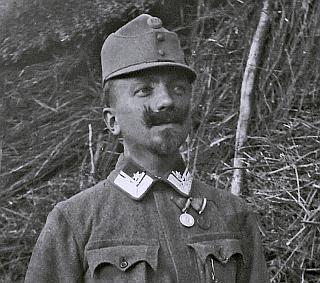
Jan Vaněk was arguably the most obvious of all the prototypes of characters in The Good Soldier Švejk.
The Who's who page on Jaroslav Hašek presents a gallery of persons from real life who to a varying degree are associated with The Good Soldier Švejk and his creator. Several of the characters in the novel are known to be based on real-life people, mostly officers from Infanterieregiment Nr. 91. Some of Hašek's literary figures carry the full names of their model, some are only thinly disguised and some names diverge from that of their "model", but they can be pinpointed by analyzing the circumstances in which they appear.
A handful of "prototypes" are easily recognisable like Rudolf Lukas and Jan Vaněk, others like Zdeněk Matěj Kuděj and Emanuél Michálek are less obvious inspirations. One would also assume that most of these characters borrow traits from more than one person, one such example is Švejk himself.
A far larger number of assumed prototypes are connected to their literary counterparts by little more than the name. Josef Švejk is here the prime example, but Jan Eybl also fits in this category. The list of prototypes only contains those who inspired characters that directly take part in the plot.
Researchers, the so-called Haškologists, are also included on this page but this list is per 15 June 2022 restricted to Radko Pytlík and two important but relatively unknown contributors to our knowledge about Hašek and Švejk. In due course entries on other experts like Václav Menger and Zdena Ančík will be added.
 | Vaněk, Jan | ||||
| *23.5.1888 Žižkov - †25.8.1927 Praha | |||||
| |||||

Vaněk on the Italian front.
Vaněk is arguably the most obvious amongst the real-life prototypes for characters in The Good Soldier Švejk. His home town, his rank and position in the army, his occupation and his marital status correspond largely to that of his literary counterpart, accounting sergeant and "drogista" Vaněk from Kralupy.
Jan Vaněk was born in Žižkov in 1888, and learned the chemist's trade in Prague. After completing his three year military service in Budějovice from 1909 to 1912, he served as an apprentice chemist in Kralupy. In 1913 he bought house No. 95 on Palackého náměstí, the Kralupy town square. Here he combined the existing chemist's and drug store into one shop. The store is still operating as a chemist's but under another name. Vaněk was married to Božena and the couple had two children: Jan and Božena.
A key witness
Vaněk provided posterity with key information about Jaroslav Hašek and his time in k.u.k. Heer, knowledge that has been drawn on extensively by Haškologists
. Vaněk kept a diary that formed most of the background for Jan Morávek's serial about Jaroslav Hašek that was published in sixteen parts in Večerní České slovo during September and October 1924. He further provided Bohumil Vlček with information that was passed on to Zdena Ančík as late as 1956. In 2014 some of his diaries were re-discovered and additional information thus became available.
Similarities and differences
Jan Vaněk was, like his counterpart in the novel, a chemist from Kralupy, was married as the novel reveals, and frequently wrote home to direct his business. The rank Rechnungsfeldwebel (accounting sergeant) that the author assigned to his literary figure was abolished before the war but was surely still in use in daily jargon so those who claim that Hašek "was wrong" may have concluded too early. Vaněk started the war as a Rechnungsunteroffizier (accounting junior officer), and is in March 1915 recorded as Reserve Korporal und Titulärer Zugsführer (reserve corporal and titular squad leader). At the time he was decorated together with Jaroslav Hašek (18 August 1915), he was functioning as Dientsführender Feldwebel (operative sergeant). His army files reveals that he was promoted to Feldwebel (sergeant) as late as 24 August 1915. On 2 October he attained the rank Stabsfeldwebel.
The first ever decorated "Einundneunziger"
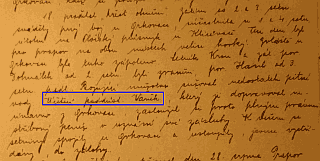
Válečné dějiny c.a.k. p. pl. č. 91.
© VÚA
18. (srpna 1914) prodělal „křest ohněm.“ Zatím co 2. a 3. setnina sváděly prvý boj u Grkovace, účastnila se 1. a 4. setnina útoku na Pločský průsmyk u Kličevače. Ten den byl pro prapor na obou místech velice horký. Zvláště u Grkovace bylo tuho zápoleno. Setník Kron a zál. por. Dohnálek od 2. setniny byli zraněni, por. Havel od 3. setniny padl. Bojující mužstvo sužoval nedostatek pitné vody. Účetní poddůstojník Vaněk, který ji dopravoval neúnavně z Grkovace, zasloužil si proto plným právem stříbrný peníz v uznání své zásluhy. K večeru se setniny spojily u Grkovace a ustoupily, jsouce vystřídány, do zálohy. Předpis Jan Ciglbauer
Information from Jan Ciglbauer (2017) suggests that Jan Vaněk may have been decorated very early. At the start of the war he served with the regiment's detached 1st battalion in Dalmatia on the border with Montenegro. Here he was decorated for his efforts bandaging wounded comrades during fighting by Grkovac fortress on 18 August 1914. According to a handwritten document stored VÚA he was the first ever Infanterieregiment Nr. 91 soldier to be decorated for bravery. Strangely enough his name is not on Rudolf Kießwetter 's (1868-1926) list of the regiment's first decorated soldiers, but this list perhaps only contains names from the three battalions that Kießwetter was in charge of (ref. Böhmerwalds Söhne im Felde). On pictures Vaněk seems to wear only two medals (one silver, one bronze). Could there have been an administrative mix-up so that he received his medal from Dalmatia only 10 months later? His Belohnungsantrag from 2 August 1915 reveals that he was already decorated with a silver medal 2nd class on 16 March 1915. At the time he was wounded, so it is presumably this medal he was awarded on 14 July (noted in his diary). Finding his first Belohnungsantrag will shed further light on the issue.
White spots

Verlustliste Nr. 161, 15.4.1915
The first 11 months of Jan Vaněk's service during the war are poorly documented. Apart from the information about his activities in Dalmatia we know that he was in the field from the outbreak of war until he was wounded on 1 March 1915. This is information from his Belohnungsantrag (2 August 1915) and is underpinned by Verlustliste Nr. 161 (15 April 1915). Here he is listed as wounded, belonging to IR. 91 5th company (i.e. 2nd battalion) and his rank is the somewhat cryptic reserve corporal and titular squad leader. The 2nd battalion was at the time fighting in the Carpathians. So at some stage between August 1914 and February 1915 he was transferred from the 1st to the 2nd battalion. Unfortunately the main service records for his year of birth were destroyed during the 1970's (Dr. Christoph Trepperberg, Kriegsarchiv, Vienna). It will thus be difficult to map his early war-time career unless the missing diary from this period is found or circumstantial documents are discovered. According to Augustin Knesl (1988), Jan Morávek never returned the material he borrowed for his 1924 series about Jaroslav Hašek and IR. 91.
Meeting Hašek
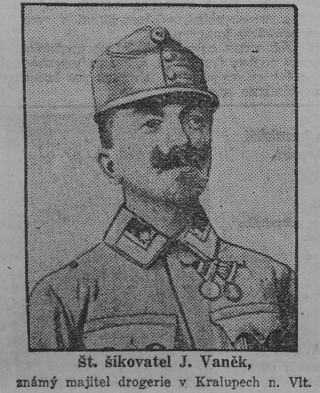
Večerní České slovo, 1924
From around 1 June 1915 his whereabouts are well documented, partly due to Jan Morávek, but mainly information from his own diaries. Vaněk was one of the persons who was closest to Jaroslav Hašek in IR. 91. The author was from 25 May 1915 partly "superarbitrated" and assigned lighter duties (rescue duties) for health reasons, and assisted with accounting and administrative work. This gave him valuable insight into the inner workings of k.u.k. Heer, knowledge that he used to great effect in the novel. The two knew each other already in Királyhida, and served together both in the XII. Marschbataillon and from 11 July 1915 in the III. Feldbataillon.
On one occasion Jan Vaněk expressed great gratitude to Jaroslav Hašek after he had a serious clash with reserve lieutenant Emanuél Michálek, often mentioned as a possible model for the moronic Leutnant Dub. There are however examples that Hašek assigned traits to the literary Vaněk that the real-life “drogista” never had. In the novel the author gives him a red nose attributed to excess intake of alcohol. The real-life person in fact drank very little due to stomach problems. In The Good Soldier Švejk he is also described as a shirker, a description that seems far from the truth. He was in fact decorated twice for bravery; on 14 July and 18 August 1915.
Belohnungsantrag 154663
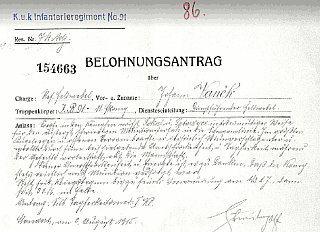
"Belohnungsantrag", 2 August 1915.
© ÖStA
Sorgte in den Kämpfen nächst Sokal und Poturzyce in todesmutiger Weise für den äußerst schwierigen Munitionsersatz in die Schwarmlinie. Im größten Kugelregen und offenen Terrain brachte er persönlich Munitionsverschläge vor und wirkte durch seine beispielgebende Unerschrockenheit und Tapferkeit während der Gefechte vorteilhaft auf die Mannschaft. Seiner Unerschrockenheit und Energie ist es zu danken, dass die Kompanie stets reichlich mit Munition versorgt war. Steht seit Kriegsbeginn bis zu seiner Verwundung am 1. 3. laufenden Jahres, dann seit 30. 6. im Felde.
Antrag: Silberne Tapferkeitsmedaille 1. Klasse.
Standort, am 2. August 1915
Transkription dank Doris & Gert Kerschbaumer
In reward for his efforts during the battle of Sokal, Vaněk was awarded a bronze medal for courageous behaviour. The medal was handed out in Żdżary (15 km north of Sokal) on 18 August 1915 by Rudolf Kießwetter . On 2 August he was proposed a 1st class silver medal, and it's unclear why it wasn't accepted and he in the end was awarded a medal two levels down. According to his Belohnungsantrag it was his personal effort that made sure that the company always was well supplied with munition. He personally carried munition crates through hails of rifle fire in open terrain and by his example he had an encouraging effect on the men.
Chorupan
Jan Vaněk recorded several of Hašek's war-time poems in this diary and it is thanks to him that these poems are known today. He was also one of the last persons who saw Jaroslav Hašek before he was captured and passed his experiences on to Jan Morávek who in turn published them in 1924. The humorist reportedly was in no hurry to get away as the Russians attacked by Chorupan in the small hours of 24 September 1915. In the aftermath Vaněk was interrogated in Bruck about the case (according to Morávek).
Vaněk's diaries
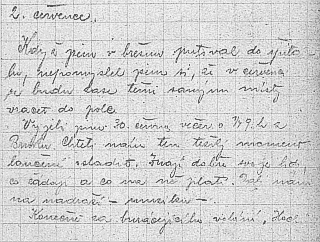
Vaněk's diary, 2 July 1915

"14 July, I was decorated"
The discovery of Jan Vaněk's war-time diaries in Kralupy in May 2014 has provided Haškologists with priceless new information and vital confirmatory evidence. Although not every day is covered, the notes give a good overview of the movements of Jaroslav Hašek from Királyhida 30 June 1915 to the time of his capture 24 September 1915. It verifies the route of the 12th march battalion better then any other document we know of so far, and confirms that Hašek's poem The road to the battlefield was indeed very precise in a geographical sense.
The diary reveals that the XII. Marschbataillon departed from Bruck station at 8:15 PM on 30 June 1915, travelled across Győr, Budapest and Miskolc. By 2 July they had arrived in Humenné and on 4 July they were still en route, waiting close to Sambor. On 5 July they (presumably) left Sambor for the front were they joined the regiment on the afternoon of 10 July. The diaries are from the private archive of Hana Svobodová, grand-daughter of Jan Vaněk.
The archive also contains notes from his peace-time service in Budějovice before the war and a number of rare photos. Unfortunately his notes from autumn 1914 and the first half of 1915 are missing. These would have revealed when and how he met Jaroslav Hašek and also revealed to which extent the anecdotes from Serbia and the Carpathians that the author assigns to him are authentic.
The rest of the war
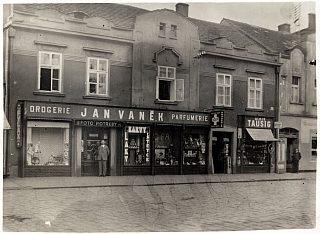
Drogerie Vaněk, Kralupy nad Vltavou
In the aftermath of the battle Vaněk was called in for interrogation about Jaroslav Hašek back in Királyhida. In early November 1915 the regiment was transferred to the Isonzo front in Italy. His diary that also cover 1916, 1917 and 1918, reveals that he on 8 November 1918 received a letter from the army command, acknowledging his war effort. In December he had a quick break, but Christmas 1915 he spent in the field. On 26 January 1916 he was wounded and sent to a field hospital and from there to a hospital in Vienna.
After recuperation and a holiday he was back with Ersatzbataillon IR. 91 in Bruck in June. On 8 July 1916 he reported ill and on his own request send to Kralupy for a short rest. Back in Bruck he served in various capacities, for instance escorting prisoners to Vienna. The rest of the year he suffered from health problems, but spent some time ambulating between recuperation centers, leave and the replacement battalion in Bruck.
In late March 1917 he was back at the front in Italy but soon fell ill again, and was diagnosed with a heart condition. The rest of the year he mostly spent at home, and only on 20 March 1918 he reported in Bruck, but he never went back to the front. He had a short stint with Infanterieregiment Nr. 75 in Debrecen but when Austria-Hungary collapsed he was back in Bruck. He witnessed the collapse and plundering of the military camp in Királyhida. Finally on 2 November he left for home.
News about Vaněk's death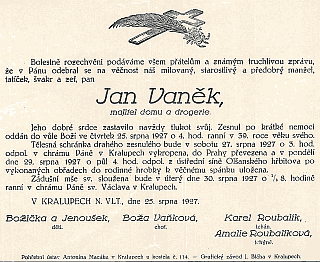
On a picture from Bruck late in the war he wears four medals, including the two he was awarded in 1915. The circumstances surrounding his two latest decorations are unknown.
Aftermath
He died at the age of 39 and was buried at Olšany in Žižkov. In 2012 his remains were transferred to Kralupy where he has found his final resting place in the family grave. His shop at the square in Kralupy is still operating but very much changed.
Some of his descendants still live in Kralupy and thanks to them the priceless above-mentioned diaries and photos were discovered in 2014!
Sources: Hana Svobodová, Jan Morávek, Bohumil Vlček, ÖStA, Jan Ciglbauer, Jaroslav Šerák, Kamil Hainc, Miroslav Fér
Literature
| © 2008 - 2024 Jomar Hønsi | Last updated: 14.4.2024 |



